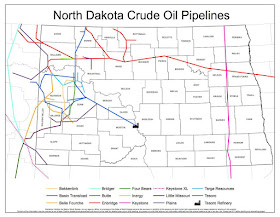Pipeline Owner: North Dakota Crude Spill Larger than First Estimated
By Liz Hampton | March 28, 2017
A crude oil spill in western North Dakota in December is now believed to be about three times bigger than originally estimated, pipeline owner True Companies said, making it the largest crude leak to affect water in the state in over a decade.
The Belle Fourche crude oil pipeline spilled an estimated 12,615 barrels of oil, more than the December estimate of 4,200 barrels, spokeswoman Wendy Owen said in a phone call.
The spill is the second-largest crude spill in the state in more than 15 years, behind a 20,600-barrel leak by a Tesoro Logistics LP pipeline in 2013, according to data from the Pipeline and Hazardous Materials Safety Administration.
Around 80 percent of the cleanup is complete, Owen said, noting the incident occurred following ground movement. Oil from the pipeline leaked into the Ash Coulee Creek and on a hillside.
The pipeline operator has collected around 3,900 barrels of oil from the creek by skimming and vacuuming, Owen said. No oil moved further down the creek, which feeds into the Little Missouri River and eventually flows into the Missouri River, a major source of drinking water, she said.
The North Dakota Department of Health has not yet completed a subsurface investigation on the hillside affected by the leak to confirm how much oil remains, agency program manager Bill Seuss said by phone.
The spill was not originally detected by monitoring equipment, which True Companies has said was likely due to its intermittent flow.
The spill occurred about 150 miles from where the Standing Rock Sioux tribe and environmentalists were protesting Energy Transfer Partners’ controversial Dakota Access Pipeline. Those groups said a spill could contaminate drinking water.
President Donald Trump signed executive orders paving the way for the Dakota Access Pipeline and TransCanada Corp.’s Keystone XL shortly after taking office. On March 24, he issued a presidential permit for the Keystone XL.
The six-inch North Dakota pipeline has capacity to move 24,000 barrels per day, at a maximum rate of 1,000 barrels per hour.
While Belle Fourche’s impacted line remains shut for cleanup operations, another line is moving crude oil from its origin and receipt points.
The incident led to U.S. pipeline regulators ordering the company to improve leak detections, along with other actions.






